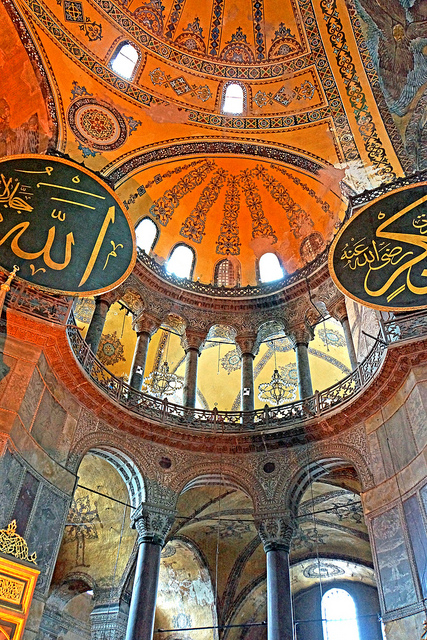
Part of the interior of the Hagia Sophia. Photo by Dennis Jarvis, and used under a Creative Commons license.
While today it is a museum, the Hagia Sophia served for a thousand years as a Christian church and for almost 500 years as a mosque. For hundreds of years, it was the largest enclosed building on the planet.
We’re going to use the Hagia Sophia as a case study that lets us begin to understand how sacred structures come into being and how they change—physically, and in their meanings—over time.
Your activities for this first part of week 4 are as follows:
- Read the Wikipedia entry on Hagia Sophia to begin to learn about its history, its architecture, and its art.
- Watch Hagia Sophia: Istanbul’s Mystery (52 minutes).
- Select an interesting topic or topic cluster from the Hagia Sophia topic sign-up sheet. Enter your name next to the unclaimed topic that most interests you.
- Write a 250- to 300-word blog post summarizing your topic or topic cluster. Explain how the topic relates to the Hagia Sophia. (Sometimes, the Wikipedia pages on these topics are a good place to start. Other times, the Hagia Sophia museum website will provide good information. Google is also your friend. Regardless which sources you use, cite them by linking to them.) Illustrate your post with relevant photos, again citing the photos’ sources. (Tip: The photos of the Hagia Sophia on this page in Flickr are Creative Commons-licensed, which means you can use them without worrying about violating copyright. Be sure to include a link back to the photo’s page, as it’s important to give credit to the photographer.)
- Read at least of your peers’ entries, and leave comments letting the authors know what additional questions you have about the topic. As a class, let’s try to make sure everyone gets asked at least question; if you see a blog post already has two or more questions, read a different post and ask questions there.
- Use the comments section of your own post to attempt to answer, briefly, questions other students asked in the comments below your post.
- Take notes for yourself—you’ll use these later—on how the spiritual and cultural meanings, as well as the physical structure, of the Hagia Sophia have changed over time. How are the physical structure and its spiritual/cultural meanings linked? How has structure influenced cultural practice, and vice versa?
Post due Tuesday, February 2 by 11 p.m. Before publishing, remember to check the categories for your group number and the assignment name.